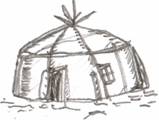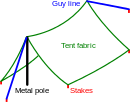Yaranga


A Yaranga (Chukchi: Яраӈы, Yarangy) is a tent-like traditional mobile home of some nomadic Northern indigenous peoples of Russia, such as Chukchi and Siberian Yupik.
A Yaranga is a cone-shaped or rounded reindeer-hide tent.[1] It is built of a light wooden frame covered with reindeer skins or canvas sewn together.
The word yaranga comes from the Chukchi word for house: jaraŋə (Cyrillic: яраӈы).[2] In Russian use, the terms chum, yurt and yaranga may be used interchangeably.
Chauchu Chukchi
It is built of a light wooden frame covered with reindeer skins sewn together. A medium-size yaranga requires about 50 skins.
A large yaranga is hard to completely heat up. There is a smaller cabin called a polog built inside it, that can be kept warm and cozy.[3]
Siberian Yupik and Anqallyt Chukchi
The most numerous of the Siberian Yupik peoples, the Chaplino Eskimos (Ungazigmit) had a round, dome-shaped building for winter. Literature refers to it as a "yaranga", the same term which the Chukchi people use, but the term used in the Chaplino Eskimos' language is mengteghaq (IPA [mɨŋtˈtɨʁaq], extended Cyrillic: мыӈтыӷаӄ).[4] Its framework was made of posts.[5] Tarpaulins were used for covering the framework. The yaranga was surrounded by sod or planking around the base. There was a smaller cabin within the yaranga at the rear, used for sleeping and living. It was separated from the outer, cooler parts of the yaranga with haired reindeer skins and grass, supported by a cage-like framework. In the language of Chaplino Eskimos, it was called [aːɣra], a word borrowed from the Chukchi language. Household duties were done in the larger outer room of the yaranga in front of this inner building. In winter storms, and also at night, the dogs were there. This room for economical purposes was called [naˈtɨk].[6]
There were also other types of buildings among Chaplino Eskimos: [aːwχtaq] was a modernized type,[7] and [pəˈlʲ̥uk] was used for summer.[8]
See also
Notes
- ^ Countries and Their Cultures - Chukchi: Living Conditions
- ^ Collis, Dirmid R. F. "Arctic Languages: An Awakening". Unesco, 1990. page 72
- ^ "Chukchi art".
- ^ Рубцова 1954: 514
- ^ Рубцова 1954: 515
- ^ Рубцова 1954: 100–101
- ^ Рубцова 1954: 518–520
- ^ Рубцова 1954: 521
References
Latin
- "Chukchi art".
Cyrillic
- Рубцова, Е. С. (1954). Материалы по языку и фольклору эскимосов (чаплинский диалект) (in Russian). Москва • Ленинград: Академия Наук СССР. The transliteration of author's name, and the rendering of title in English: Rubcova, E. S. (1954). Materials on the Language and Folklore of the Eskimoes, Vol. I, Chaplino Dialect. Moscow • Leningrad: Academy of Sciences of the USSR.
External links
- Поселок Унгазик (Чаплино) (in Russian). Музея антропологии и этнографии им. Петра Великого (Кунсткамера) Российской академии наук. Archived from the original on 2009-02-28. Rendering in English: Ungazik settlement, Kunstkamera, Russian Academy of Sciences. Old photos about former life of a Siberian Yupik settlement, including those of a various house types, both inside and outside.
- Photographic collection of A.S.Forshtein in the Peter the Great Museum of Anthropology and Ethnography (Kunstkamera), Russian Academy of Sciences

